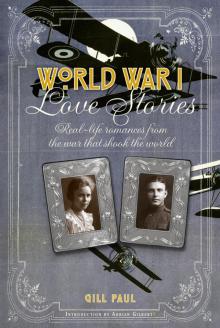World War II Love Stories Read online
Page 13
Dorrit had always been a keen dancer and it turned out that Hedley was pretty nifty on his feet, too. As they danced the jitterbug, the jive, and the foxtrot, the dance floor cleared and people stood watching. At the end of the evening, the prize was theirs. Hedley let her take it home to her mother, because as a Canadian serviceman he was well fed. But the dance contests that were common at that time gave him an excellent excuse to invite her to come dancing with him again.
Dorrit had dated a few other men, but soon she began seeing Hedley exclusively. One thing they had in common was that they were both outsiders, and after the first few dates it became clear that things were getting serious. “You do know I’m Jewish, don’t you?” she asked, feeling it was only fair to warn him. He grinned and replied, “I don’t care. I love you. Besides, you do know I’m black, don’t you?” “I don’t care, either,” she replied.
Showing off their moves: American servicemen at the Rainbow Club near Piccadilly Circus, London, January 27 1945.
Life in Canada
When Dorrit announced in the spring of 1945 that Hedley had asked her to marry him, her mother tried to talk her out of it. Dorrit was barely 21 years old, Hedley was black and non-Jewish, and he would probably want to take her only daughter back to Canada. She argued against the match, but Dorrit would not be swayed. In June 1945, a civil ceremony was performed in London, making them man and wife. A friend of Hedley’s was one of the witnesses and his future mother-in-law, Irma, was the other. A shock awaited them when they signed the marriage register. Hedley had told Dorrit he was 21, like her, but in the register his age was recorded as 33—a full 12 years older. Irma was furious about the deception, but Dorrit shrugged it off. Age doesn’t matter when you are in love.
Dorrit’s mother, Irma, carefully cut Hedley’s image off this picture of Dorrit with her new baby Diane. Irma found it hard to accept the relationship.
There was good news at last when they heard that Dorrit’s father was alive and well, having survived the war in Palestine. He came to London in the summer of 1946 to find that his little daughter had married and was herself the mother of a baby girl called Diane. At the same time, they learned that other relatives had not been so fortunate; nothing was ever discovered as to the fate of Dorrit’s grandmothers and the uncle who had been sent to the concentration camps.
Hedley was repatriated to Canada with his military comrades in September 1946. He was followed by Dorrit, who sailed out on the Empire Brent in October, along with hundreds of other war brides, on one of the special sailings arranged by the Red Cross. She came ashore in Halifax with her five-month-old daughter and caught a train to Fredericton to be reunited with her husband. It was then that Hedley’s second falsehood came to light. He had told Dorrit that he owned a chain of garages and led her to believe they would have a comfortable lifestyle, but reality became clear when she arrived at the tiny shack where Hedley’s parents lived with all his siblings. It was November and already the winter was unbelievably cold, with snow thick on the ground. There was no electricity, so Dorrit had to find her way at night using oil lamps. There was no indoor plumbing and the toilet was some distance away from the house, so a call of nature meant donning jackets and overshoes to plod through the snow. Dorrit was stunned by her change in circumstances, but stuck in a foreign land she had no recourse but to make the best of it. Fortunately, her husband’s large family was kind and welcoming.
WAR BRIDE CROSSINGS
The end of the war and the subsequent repatriation of troops meant that hundreds of thousands of couples, many of them with young children, were separated. The Red Cross stepped in to look after the women and children left behind, to counsel them in preparation for life overseas, organize paperwork, arrange war bride sailings, and accompany them on the journey to their new homes. In some cases, they provided ongoing help for years after the war, including assistance for women who became too homesick and decided to return to their countries of origin because they couldn’t adjust to life in a new land. The first official sailing of a war bride ship was in January 1946, when the SS Argentina took 452 women from Southampton to New York, to be met by the mayor, a band playing, and 200 journalists and photographers. War bride sailings continued until 1948, involving hundreds of ships, and were given many slang names, including “The Diaper Run” and “Operation Mother-in-law.”
There was a spirit of camaraderie on war bride crossings and many women made lifelong friendships.
In March 1947, after a winter staying with the in-laws, Hedley and Dorrit were able to rent a house of their own in Fredericton. The house had an indoor toilet and the luxury of hot running water. Hedley got work as a laborer, and then as a piece worker in the Chestnut Canoe Company, but despite working long hours, he earned very little. Dorrit became expert at producing meals out of beans, potatoes, or macaroni along with any meat that was on sale. Two more daughters were born—Denise and Deby—and when the girls were old enough they walked the mile or so to the local school.
Dorrit and Hedley: dancing brought them together and they never missed a chance to have a twirl.
…Hedley and Dorrit remained in love throughout 57 years of marriage, and retained their love of dancing.
Poverty was not the family’s only problem. They were the first mixed-race family in Fredericton, living in a white community, and they encountered a certain amount of prejudice. Although Dorrit and Hedley had many friends and often entertained them at the family home, invitations were not returned because white neighbors didn’t want a black man in their house. Dorrit attended events at the local synagogue, but her husband was discouraged by the Jewish community from accompanying her. The girls were told they couldn’t swim in certain swimming pools or take part in athletic events; there were some places that people of color could not go. All the same, Hedley and Dorrit’s daughters did extremely well at school—an achievement that astounded Dorrit, who was unable to help them with homework since her own academic education had been so curtailed.
Dorrit’s mother, Irma, went back to Vienna sporadically to be with Alfons, but she was hurt by his lack of support during wartime and spent more and more time with her daughter and grandchildren in Canada. Although she never forgave Hedley for the lies about his age and his circumstances, she couldn’t contemplate losing touch with her only child and, after Alfons died, she came to live in Canada.
Despite all the challenges and the world of difference between them, Hedley and Dorrit remained in love throughout 57 years of marriage—and both retained their love of dancing. At social events—including their daughters’ weddings—they got up to jive or jitterbug, just as they had back in wartime, and they always cleared the floor.
Roy Sather & Pill Denman
Pauline and Roy saw each other three times a day on Tinian. They spent their days going to the beach, playing games, talking—and falling in love.
It was an idyllic romance on a tropical island between two people who simply clicked. “Practice signing Mrs. Roy O. Sather,” Roy told Pill the day before she was shipped off to Japan to finish her tour of duty. She had no doubt that they would spend the rest of their lives together.
By the summer of 1945, Roy had already endured a long, tough war. After studying electrical engineering at Wayne State University, he had signed up for the Air Corps and was sent to a training camp in Salina, Kansas, where he learned to fly fighter-bombers. In 1941, he got a job as a flight instructor and was sent for a tour of duty in Northern Ireland. In May 1943, he joined the newly formed 468th Bombardment Group, the first to fly high-altitude B-29 aircraft on overseas missions. These were brand new planes with lots of technical issues to be resolved before they were sent to Calcutta, India in March/April 1944, for use in the China–Burma–India theater. Their initial missions involved flying “over the hump”—the Himalayas—to take fuel to an advanced base in Szechuan province in China. Then on June 5, 1944, the 468th flew their first bombing mission over Bangkok, Thailand, before later attacking military tar
gets in Japan. Roy was a radar operator—“a near-genius, the best in the business,” according to his commanding officer. He flew 17 successful missions altogether.
Roy began his army career as a lieutenant in Northern Ireland.
B-29s of the 468th Group dropping their payloads over Rangoon in Burma.
FLYING THE HUMP
China had been at war with Japan since 1937, and the American strategy in this conflict was to supply aid to the Chinese to help them fight back. Once Burma had fallen to Japan in May 1942, this could only be done by air from India. From July 1942 until November 1945, 650,000 tons of supplies were flown over “the hump” amid treacherous flying conditions. There were steep ascents, as they rose from sea level and had to clear ridges of up to 16,000 feet; winds could gust at up to 200 mph, causing severe turbulence; and the planes would often either overheat or get iced up at altitude. Mechanical failure was common and spare parts were hard to come by—and there was also the added danger of attack by Japanese fighter planes. At least 509 planes were lost flying “the hump,” with 1,314 air crew members killed, while approximately 1,200 men were rescued after crashing. Roy wasn’t joking when he said flying was dangerous!
Flying “the hump” was treacherous, but with breathtaking views of the Himalayas.
By the end of 1944, the 468th had the best operational record of the four B-29 bomb groups then in existence, for which they were rewarded with the title “The General Billy Mitchell Group” (after the man credited with creating the United States Air Force). The work was undoubtedly challenging, as the B-29s were still prone to technical problems, and every mission was a trial of nerves lasting between 16 and 21 hours before they were safely back at base. “I used to fly until I found out how dangerous it was,” Roy quipped to friends, typically making light of the very real peril he had been in.
In May 1945, the 468th were relocated to Tinian, one of the Mariana Islands southeast of Japan, which had been liberated from Japanese occupation the previous summer. One end of the island was completely fenced off for a top-secret mission involving B-29s, but few knew precisely what that might involve. All they knew was that the boundary was guarded and that something big was going on.
Life was more relaxed on Tinian than it had been in Calcutta, with fewer missions to fly, and Roy enjoyed going to the beach and exploring the island in a jeep borrowed from the motor pool. There were dances at the officers’ clubs and one night he spotted an attractive girl with blonde hair and glasses and he thought she looked fun. He contrived an introduction and found out that her name was Pill (short for Pauline) and she was a nurse. They started chatting, then something happened that neither had expected: there was such an intense, immediate attraction between them that the rest of the world faded into the background. From then on, for the remainder of their time on Tinian, they only had eyes for each other.
…there was such an intense, immediate attraction between them that the rest of the world faded into the background.
Love in the Tropics
When she graduated from high school in Delmar, New York, Pill Denman had no idea what she wanted to do with her life. Her friend Cookie announced she was going into nursing, and Pill thought, “Why not?” She soon found she enjoyed the job and after earning her RN in 1943, she decided to join the army to do her part for the war effort. Her first assignment was working night shifts from 6:00 p.m. to 6:00 a.m. on an obstetrics ward in Fort Monmouth, New Jersey, and after a few months of that she signed up for overseas service. She hoped to be sent to Europe, and packed her warmest clothes, but the war in Europe was coming to an end just as she arrived for training at Camp Kilmer, New Jersey; she was told she would need summer clothes, since her next stop would be the Pacific. There was just time to learn about the symptoms of malaria before she and the other volunteers were sent by train to Seattle, Washington, where they would embark. They didn’t know where they were going when they set sail on July 17, 1945, but the speculation was excitement enough.
Their ship docked at Tinian Island in the Marianas and the girls were shown to Quonset (prefabricated steel) huts on the island’s east side, where they would sleep 25 or 30 to a room and share an outdoor latrine. There wasn’t any nursing to do, so after they had finished a few chores, their days were their own. Pill had only been there a week when she met Roy, and although she was fairly casual in her letters home to her parents, she began to mention him in every one: “He’s an awfully nice fellow … honest and faithful and has a lot of grey matter under his thinning red hair … I think an awful lot of him.” In fact, she was soon smitten and didn’t have eyes for anyone else, as she and Roy spent all their free time together.
Roy slept in a tent on the west of the island where all the officers were based, but every morning after breakfast he would drive the four miles over to Pill’s hut. In the hours they were apart they used to write letters to each other, so the first thing they did was read the letters each had written in bed the night before. They played games of cribbage and Sink (a form of Battleship), they filled out crossword puzzles, which both enjoyed, and the whole time they talked—about his father who had died in World War I, soon after he was born; about her older sister, Marjorie, who was a secretary; about his time as a cross-country running champion; about the experiences she’d had as a nurse. Their conversation was one long stream that never ran out—except when they stopped for passionate kisses.
In the afternoons, they generally went to the beach to swim and goof around in the sand, and every evening after dinner they went out: to a drive-in movie, dancing, or for rum and cokes at one of the officers’ clubs (their favorite was the Dreamboat, which had the great luxury of an indoor toilet). It should have been perfect, but Roy had a secret weighing on his conscience. One day he asked Pill out for a long walk and began, hesitantly, to tell her about a friend of his who had a problem. The friend, he said, was engaged to a girl called Irene, but he wasn’t in love with her and now he had fallen for a nurse on Tinian. What should he do? Pill could guess from the nervous way he spoke that he was talking about himself and she answered carefully. She said his friend should go back to the United States and see his fiancée again before making any final decisions. That way he would know for sure if he were doing the right thing. Roy confessed to Pill that it was him and showed her photos of Irene. “But I want to be with you,” he said. “You’re the one I love.” There was such emotion in his voice that she knew for sure he meant every word.
Roy with Irene Markham, his fiancée before the war.
The ground crew of the Enola Gay, with its pilot Colonel Paul W. Tibbets in the center.
On August 6th, they heard planes taking off from the north end of the island where the secret base was located, and heard later that the flight had included a plane called Enola Gay, which had dropped a very special kind of bomb. Roy was curious but Pill didn’t give it much thought at the time. Then on August 9th, another bomb was dropped, and on the 15th came news that Japan had surrendered (see here). The war was over, bringing with it huge relief that Roy and his comrades wouldn’t have to risk their lives any more. There were special celebrations on Tinian that night, and Roy and Pill sat holding hands on the terrace of the Dreamboat Club, watching the planes return from their final missions.
The marriage license Roy made out in his and Pill’s names, suggesting a wedding date of November3, 1945.
A Sad Goodbye
Military personnel came and went from Tinian all the time. Roy had come to the end of his tour and could have gone home soon after VJ Day, but Pill was committed to working for six months after the end of the war, so he kept negotiating extensions simply so that he could stay with her. All the time things were getting more serious between them. He took her for lunch in the officers’ mess and introduced her to his commanding officer, Colonel Jim Edmundson. One day he presented her with a marriage license he had made out in their names, suggesting a wedding date of November 3rd. He gave her his engraved chain-link bracelet and his Air Fo
rce dog tag. And all the time he told her how much he loved her, though she knew he did, and she explained that she loved him, too. Everything about it felt completely right, as if it had always been meant to be.
Then Pill was told that she would soon be sent to Japan to nurse American troops stationed there. It broke her heart to think of leaving Roy, but he reassured her that he would write to her twice a day, and that she just had to get through the final months of her service so that they could then be reunited. On October 19th, the day she left, as there were no jewelry stores on Tinian where he could buy her a ring, he gave her his gold, engraved Parker 51 pen and pencil set as what he called “an engagement present,” and told her to practice writing “Mrs.” before the name on that pen. He didn’t get down on bended knee but, all the same, this proposal was the only thing that comforted Pill as her ship set sail across the Pacific.
True to his word, Roy wrote twice a day, sending news of their friends on Tinian and telling her how much he missed her. The mail wasn’t always regular, so on November 15th she received fourteen letters from him all on one day, while on other days she received nothing at all. Pill missed him terribly but soon settled to her life in Japan. There were no gunshot wounds or bomb-blast injuries to deal with; the men she was nursing had nothing more serious than a hernia or appendicitis. She visited Hiroshima and found a barren landscape of nothing but ashes; shocked, she wrote home, “It is impossible to put into words the destruction caused by that one small powerful bomb.”

 The Collector's Daughter
The Collector's Daughter The Lost Daughter
The Lost Daughter Jackie and Maria
Jackie and Maria The Affair
The Affair Love...Maybe
Love...Maybe The Secret Wife
The Secret Wife No Place For a Lady
No Place For a Lady Another Woman’s Husband
Another Woman’s Husband World War I Love Stories
World War I Love Stories World War II Love Stories
World War II Love Stories